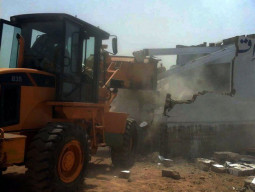
“The problem is that the LBOD was designed to drain 4,000 cusecs of water but so far more than 20,000 cusecs of water has been drained from it.” He added that a research would be conducted to look into the issue and try to overcome it.
While speaking at a joint press conference with officials from the Chinese company that plans to help rehabilitate the flood-affected districts, Dharejo said that the government was not only working on the LBOD project but had started to conduct a research on how to get rid of the poisonous water which was flowing into Ghotki from Punjab.
The water has ruined hundreds of acres in the district and they were planning to conduct another research project which would deal with how to divert saline and seawater in order to irrigate barren land. The irrigation minister said that the government was planning to seal the deal with a British company on October 17 and conduct a study to increase the capacity of the Sukkur and Guddu barrages.
“The top priority of the government is to drain the flood water so people can start sowing the seeds for the Rabi crop by October 17,” he said. “There have been some tough situations especially in areas where there is no proper irrigation network.” He added that they were working around the clock to drain water from the districts.
While discussing the flood situation in his office on Wednesday, the minister said that 95 per cent of accumulated water had been pumped out of the rain-affected districts and the Sindh government had signed a contract with a Chinese company to rehabilitate and strengthen the irrigation system.
According to Dharejo, the project would cost around Rs6.25 billion and should be completed in two years. He added that although they had made short- and long-term strategies to deal with the irrigation systems in the province, the encroachment on drains and canals could create a problem.
On the topic of encroachments the irrigation minister said the President Asif Ali Zardari had put together a committee which would remove encroachments on the River Indus, canals, drains, ponds and lakes.
Published in The Express Tribune, October 13th, 2011.
COMMENTS (2)
Comments are moderated and generally will be posted if they are on-topic and not abusive.
For more information, please see our Comments FAQ

















If you want know what is LBOD, and whats the reality behind it, kindly check following link,
http://www.sida.org.pk/flood/Flood%202011/files/(12-10-11)%20Article%20on%20LBOD%20for%20yellow%20pages%20of%20dawn.pdf
Dear Sir, The floods in Sindh especially on the left bank of Indus river have become a constant threat to the population and property . SIDA has engaged some of the foreign consulting firms to investigate the problems of flooding and drainage so that a suitable solution could be sought out. However, the problem is so big that one firm with limited qualified staff is unable to cope with the entire scenario. It is suggested that these foreign firms may please be advised to associate with them local experienced engineering firms dealing with various aspects of water ressources, drainage of irrigated and agricultural lands, and disposal of saline effluent especially for growing of salt tolerant crops.
Setting up hydrologic modeling is very important for the prediction of flood peaks at various locations from Guddu to Delta Area. For this, rainfall on hourly basis is required. But according to my inquiry from the Meteorological Department ,Karachi, no such arrangements and facilties are available anywhere in the area of left bank. Only daily rainfall data is available at some stations, but the Meteorological Department demands heavy charges to supply the rainfall data. The cost is unbearable for any research worker.
Another suggestion is to store rainwater in either natrually occuring depressions or in artifical ponds. Huge amount of rainwater can be harvested in this ways for its use during dry period or in winter for cropping. Furthermore, this excercise would refresh the underlain saline groundwater and by this technique, even the ground water can thus be used safely for irrigation through instasllation of shallow pumping wells.
Finally, modeling of drainage water quality should also be carried out so that the water that can be used for agriculture could be properly planned for its utilization and only the most unfit water may be thrown into the sea. with these remarks , i thank you for giving me opportunity to express my views
DR.MUHAMMAD AKRAM Ph.D. Berkeley,USA